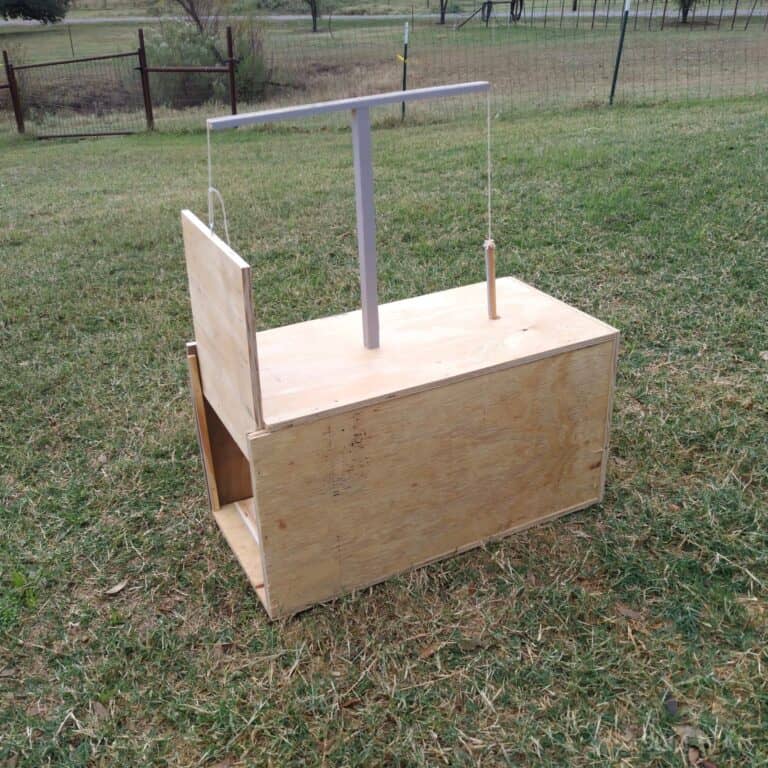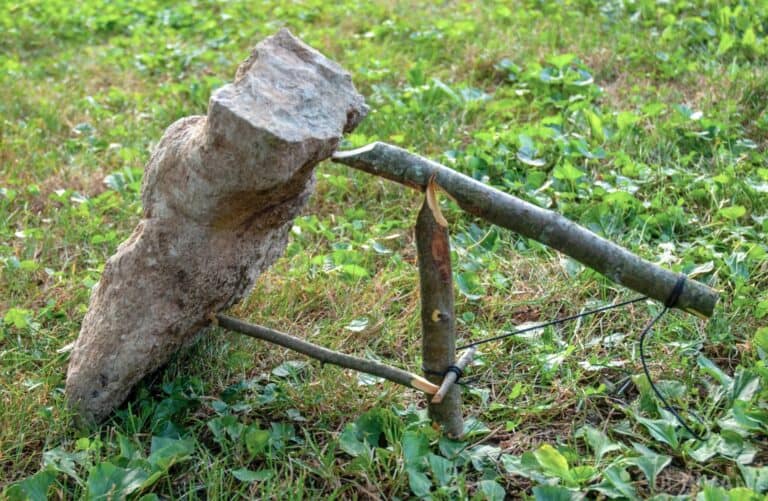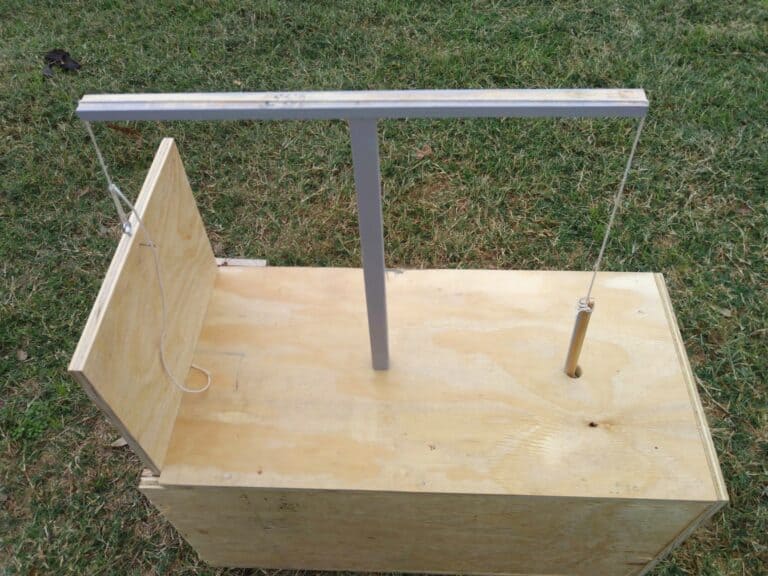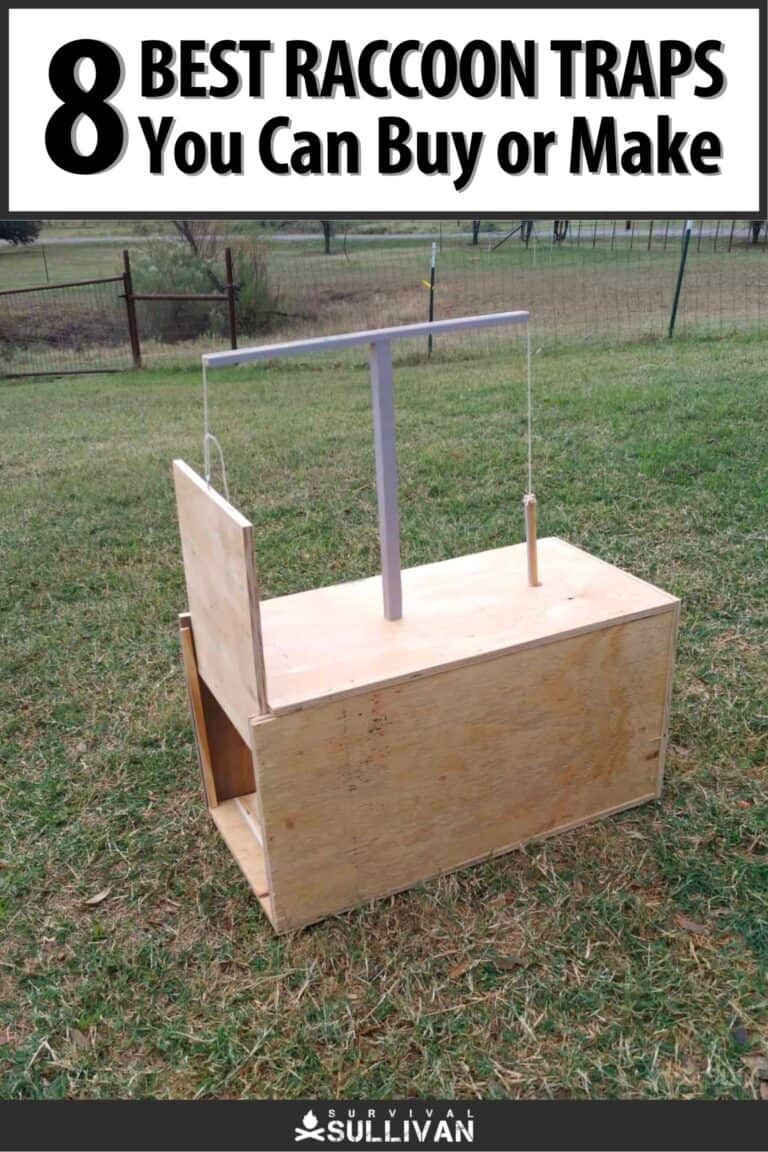Raccoons. Trash pandas. Whatever you call them, and whether you love them or hate them, raccoons are a more or less constant presence across much of the North American continent.

With incredibly dexterous hands and that charming black mask, raccoons have legions of fans across the world and all over the internet. They are harmless enough… as long as you aren’t the one dealing with them!
Raccoons have well-deserved reputations for thievery, trickery, and being a top-grade pain in the butt… They loot trash cans, make messes, steal your freshly grown produce, and are not above stealing eggs from chickens and other birds.
If you are the unfortunate target of a gang of raccoons, your aggravation and stress levels are probably going through the roof. Even worse, they often travel in packs and where you have one you’ll soon have more.
Clever, inquisitive, and possessing excellent problem-solving and climbing skills, fortifying your holdings against raccoons is usually a losing battle.
Much of the time, you’ll need to trap them, either killing them or relocating them. To help you in that endeavor we are bringing you a list of eight highly reliable raccoon traps you can use for the purpose, either purchasing them over the counter or making them yourself.
Table of Contents
Understanding the Raccoon Menace
Using these bushcraft traps, be they lethal or non-lethal, is a skill set that is increasingly dying off these days.
The successful setting of a trap, or rather setting a trap in a way that assures the successful capture of your target animal, requires creativity, patience, and most of all on insight into the behavior, reactions, and desires of your quarry.
Since we are after raccoons specifically, let us examine how raccoons behave and what motivates them.
Understanding their motivations and typical behavior will allow us to turn both against them and catch them in a trap.
This understanding will influence how we select, place, and utilize our traps to assure success.
On to the raccoon itself. What is a raccoon? A small mammal, low to the ground, possessed of incredibly dexterous forepaws that function very much like hands.
Highly motivated by food, but generally inquisitive, highly intelligent, and capable of impressive feats of climbing. This is a simple analysis but one that tells us many things.
First, we know that raccoons, like so many creatures, being highly motivated by food and therefore bait will be of much use to us.
Since they are small and low to the ground we will need traps that can capture them or contain them entirely for success.
We also know that a lethal trap need not be inordinately powerful to assure a Kill.
Because raccoons are excellent climbers, we must ensure that any trap we set will either not allow the raccoon to scale it or a nearby obstacle in order to avoid it or escape capture.
Armed with this knowledge, we are ready to select and employ our traps. So grab your bait, and make sure it is wet, stinky, and sure to appeal to these thieving critters.
Pork, roasted chicken, tuna, kitchen scraps, and more are items you likely have on hand already and any of them will serve as excellent raccoon bait if required.
Grab your gear and let us get on to the list.
The 8 Best Raccoon Traps You Can Buy or Make
The following list of traps have all been proven time and time again to be effective against raccoons.
Our list includes quite a bit of variety to serve any purpose and meet any requirement.
We have lethal and non-lethal traps, and have hopefully labeled each of them as appropriate along with a short descriptor of its operation and a quick reference section on how it is best in place or otherwise set for best results.
We will tell you everything else you need to know about the operation of the trap, how to use it, and the consequences of using it in the appropriate entries.
1. Plunger/Spear Trap
| Trap Type | Lethal, Impaling |
| Setting | Use to ambush habitual routes, entry/exit points, or with bait as lure. |
A plunger or spear trap is the type of mechanical and viciously actuated device you would expect to see in a torture dungeon or a hidden temple’s secret passage.
Note this is not a primitive spike-lined pitfall. Instead, a plunger trap relies on victim actuation to send a single Spike or multiple spikes hurtling into the body of the target.
Large and powerful versions of this trap are used to ambush underground moles as they go to and fro in their burrows but they can work just as well against raccoons.
Compared to other lethal traps, plungers have the expected list of advantages and disadvantages.
Depending on the size and actuation of the trap, these might be more or less vulnerable to having their bait swiped without activation or without lethal effect on the target.
When they are set up properly and work as expected they are extraordinarily lethal and have the added advantage of typically pinning the target animal to the ground, either preventing escape or making the subsequent coup de grace simple to administer.
It is worth noting that traps of this nature, while highly adaptable, are extremely fearsome and gruesome in operation.
You must use the uttermost care that family pets like dogs or cats or any strays could not be enticed into the trap, especially if it is utilized with bait.
Additionally, do take care if you have small children or squeamish family members as this, more than most traps, will produce a hideous corpse upon activation.
2. Body Hold / Conibear
| Trap Type | Lethal, Crushing/Squeezing |
| Setting | Use to ambush habitual routes, entry/exit points. Less successful with bait. |
Conibear or body hold traps are what most people imagine in their head when they hear the word bear trap, and ones that are sized for dispatching smaller mammals, like raccoons for instance, function much the same way.
Think of these like an industrial strength mouse trap and you are getting pretty close to the mark.
Body hold traps of this nature may utilize a single bar, twin bars or grasping jaws the powerfully clamp shut when the trigger is activated.
If it works as designed, the raccoon will be crunched around its neck or midsection preventing blood from reaching the brain or sometimes asphyxiating it.
A good catch will dispatch the animal quickly and if secured by the neck it may be fractured, potentially dispatching the animal instantly.
I must point out that traps of this nature are among the most heavily regulated in use, and some areas ban their usage outright under all conditions and others restrict them to the use by professionals in the course of professional trapping only.
I’m not trying to scold you, but do make sure you do your homework before acquiring any of these traps for any purpose, especially catching raccoons.
Anyway, when placing a body hold trap you’ll have an advantage and that they are highly adaptable to various circumstances.
They can be placed pretty much anywhere using an appropriate bait to lure in the unfortunate animal or you can stick them just ahead of or just behind a small hole or other entrance into a passageway that raccoons habitually use.
As soon as they clamber through, bam, you’ll have them!
3. Deadfall
| Trap Type | Lethal, Crushing |
| Setting | Highly successful when used with bait or to exploit food expectancy. Good when placed against long, inescapable path. |
A deadfall is one of the simplest traps to execute in theory, and one that almost everyone is familiar with at least on a theoretical level.

Chances are you first saw this trap in operation when Wile E. Coyote was trying to catch that daggone road runner! A deadfall is very simply any trap that relies on a crushing weight to kill the target.
Long used by virtually every culture around the world, they are still useful today in a variety of contexts and are one of the easiest traps to construct using found or repurposed materials.
A heavy stone or stack of cinder blocks placed atop a plank of plywood and held up with a stick might be all that is required to erect an effective deadfall.
Deadfalls may be victim-activated through the use of a triggering system or trapper activated with something as simple as a string or lanyard running to a nearby hidden observation point.
Dead falls may be placed along typical Paths of movement, particularly ones where the intended victim cannot scramble out of the way of the falling weight, but they may be set up anywhere when used with bait to entice the target animal into the Kill zone.
One crucial factor to keep in mind when employing a deadfall. Whatever you are using as a wait must be heavy and inflexible, and the weight employed in the trap should be at least five times that of the target animal.
A deadfall that is too light is only likely to maim the animal and definitely won’t hold it in place.
You have an obligation to cleanly dispatch the animal you are trying to kill, so always air on the side of heavier rather than lighter if you have any doubt.
It is also worth keeping in mind that any animal enticed under a deadfall that activates it, and survives, will likely not fall forward again in the future!
4. Drowner
| Trap Type | Lethal, Drowning |
| Setting | Freestanding, most successful with bait or to exploit natural curiosity. |
The last decisively lethal trap on our list, the drowner trap does exactly what you are likely expecting based on the name.
It drowns the target! Is a miserable death, but one that is undeniably effective and has the advantage of remaining operational even after multiple activations.
For a set-and-forget system, a drown or trap can be one of the best since it does not need to be reset, retriggered or otherwise messed with after a successful kill.
In design, a drowner trap is basically a pit or a large container serving as a freestanding pit that is filled up with enough water to prevent the target from standing upon the bottom or any of the sides.
They can swim for a little while, but eventually they will tire and then sink into the water, drowning.
Against small mammals, these traps are relatively space efficient and extremely lethal. Not quick, mind you, but lethal.
Probably the biggest advantage of a drowner trap besides its “always on” nature is that they do not inflict gruesome injuries in operation.
This makes them far safer to use if you have children or pets around, and a drowner trap that is adequate for dispatching raccoons will be absolutely no threat whatsoever to larger animals like cows or horses.
However, construction or installation of a drowner trap is usually challenging.
You can dig a hole in the ground, but digging a hole in the ground that is deep enough to provide an adequate drop while still being too tall to climb out of and it deep enough to fill with enough water is a job unto itself.
Above-ground or freestanding drowners can be made from above-ground pools or extra large containers that have a sort of teeter-tottering container placed over them with some bait in the center to entice the raccoon to walk out over the water.
Don’t forget, raccoons are agile and resilient problem solvers, and there is a non-zero chance that they can swim or jump out, so make sure the sides of your container are free of hand holds.

5. Cage
| Trap Type | Non-lethal, capturing |
| Setting | Freestanding, exploit desire for food with bait or motherly instincts with young. |
You can build a homemade raccoon trap very easily and this is by far the most humane type of trap you can employ. A cage trap is non-lethal by design.
Will only seriously injure or kill the targeted animal if a terrible accident occurs or if the person who sets the trap does not check it regularly and allows the poor creature to remain inside dehydrating to death.
A cage trap is exactly what you’re imagining, and relies on a one-way toggle entrance to trap a raccoon inside or else relies on a trigger, usually baited with food, to activate a closing door or gate behind it once they are at the far end.
Cage traps have many advantages for those battling these mischievous creatures as they may be placed in many spots relative to the typical comings and goings of a troublesome raccoon.
Baiting them with food or else collecting young raccoons from a nest and placing them inside will easily lure adult raccoons to them, allowing you to capture multiples in one go.
Best of all, once the cage trap has successfully snagged the targeted critter you can pick up the cage trap and the animal easily and conveniently for transportation to a sanctuary or elsewhere in the wild for release.
It might sound silly, but if you can believe it cage traps are also regulated in some jurisdictions even if you are not planning on killing the animal.
Be sure to check your local laws before trying to trap any raccoon, even if you’re only trapping it temporarily.
6. Pit
| Trap Type | Less-lethal, capturing |
| Setting | Freestanding, exploit desire for food with bait or motherly instincts with young. |
A pit trap is what you would define as a less lethal trap, not necessarily totally non-lethal.
Though ostensibly designed to capture, not kill, via Way of a surprise trapdoor or other mechanism that will deliver the raccoon into the pit, any pit that is large enough and deep enough to securely hold the animal might well mean an injury when they hit the bottom.
In operation, a pit trap is designed and installed very much like a drowner trap above, only the pit is not filled with water.
The depth of the pit trap must be adequate to prevent the animal from jumping out and the sides must be slick enough and free of purchase to keep the raccoon from clambering up and away.
It is difficult to overstate just how capable these little creatures are at climbing!
One technical challenge that is worth exploring and implementing if possible is the use of a one-way seesaw or teeter-totter trap door that will dump the animal in once they step on the unsupported part but then close itself and be incapable of moving in the opposite direction.
This is hardly completely foolproof against the dexterous raccoon but it will go a long way towards keeping them in the pit.
7. Foot-Hold
| Trap Type | Non-lethal, immobilizing |
| Setting | Use to ambush habitual routes and entry/exit points. Success with bait is highly dependent on trigger actuation or placement of bait. |
As you probably guessed from the name, a foothold trap is a non-lethal relative to the body hold trap higher up on this list.
These traps are designed to grasp the paw or leg of a raccoon to immobilize it in place, but are not intended to inflict lethal or maiming injuries.
I must tell you right up front, however, that these traps might still spell a death sentence if the raccoon is in a place to suffer from exposure, or if it is held so long that it dehydrates.
Desperate raccoons may chew off their own limb in order to escape. Though comparatively rare, it is a possibility.
Otherwise, these traps are effective and generally humane if you are able to act quickly enough to capture the animal.
Generally affordable, easy to set, effective with bait, and adaptable to a variety of circumstances, the foothold trap might well be your frontline choice in a major battle against a band of rampaging raccoons.
Like the body hold trap above, great caution must be used to prevent unintended targets from activating the trap, such as family pets, small children, and other wilderness creatures.
If you are going to go all in with foothold traps, you should strongly consider purchasing or upgrading the trigger on existing traps to what is known as a raccoon trigger.
Instead of activating the trap when trod upon or depressed, a raccoon trigger activates the trap when it is squeezed.
This is the perfect option for targeting raccoons specifically since those grasping paws they have will easily set off a trap of this nature whereas a dog or a cat is much less likely to set one off.
8. Snare
| Trap Type | Less-lethal, immobilizing |
| Setting | Use to ambush habitual routes, a generally good candidate for use with bait in novel circumstances. |
Snares are among the oldest, most adaptable, and most used traps employed by mankind.
Snares can be used to catch big animals and small animals. They can be employed in a lethal or non-lethal context.
They can be used with dedicated hardware or improvised from found materials. Whatever the situation, there is likely a style of snare that will work for you.
I have classified the snare as less lethal because, assuming you said it accordingly and with deliberation, it is less likely to inflict lethal injuries, typically occurring when it catches the targeted animal around the neck or the midsection.
A snare that snags a raccoon by the paw or leg will function much like the leg hold trap discussed above, hopefully keeping the animal in place until you can come along to collect it or dispatch it accordingly.
Snares, while effective, are generally easily triggered and require more babysitting than other kinds of traps.
Even if they aren’t triggered, the delicate, lightweight snare wire can be moved out of the way or otherwise messed up by the passage of nearby animals, wind, weather, and so forth, necessitating frequent checks.
Assuming you don’t mind this extra bit of work, a minimal investment in proper snare hardware could allow you to set a field of traps all over the place drastically increasing the chances that you’ll catch a loan raccoon or a small group.
Conclusion
Raccoons are adorable, but if they’re on your property breaking into your trash, hassling your livestock, or stealing your food they definitely fall into the category of pest mammals.
If animal control isn’t offering you any help, you have options for taking care of the problem yourself and any manner you choose, be it lethal or non-lethal.
The list above should give you plenty of ideas or options for purchase and with a little bit of prior preparation you can rest easy knowing it is only a matter of time until you bag the troublesome raccoons.


Tom Marlowe practically grew up with a gun in his hand, and has held all kinds of jobs in the gun industry: range safety, sales, instruction and consulting, Tom has the experience to help civilian shooters figure out what will work best for them.
